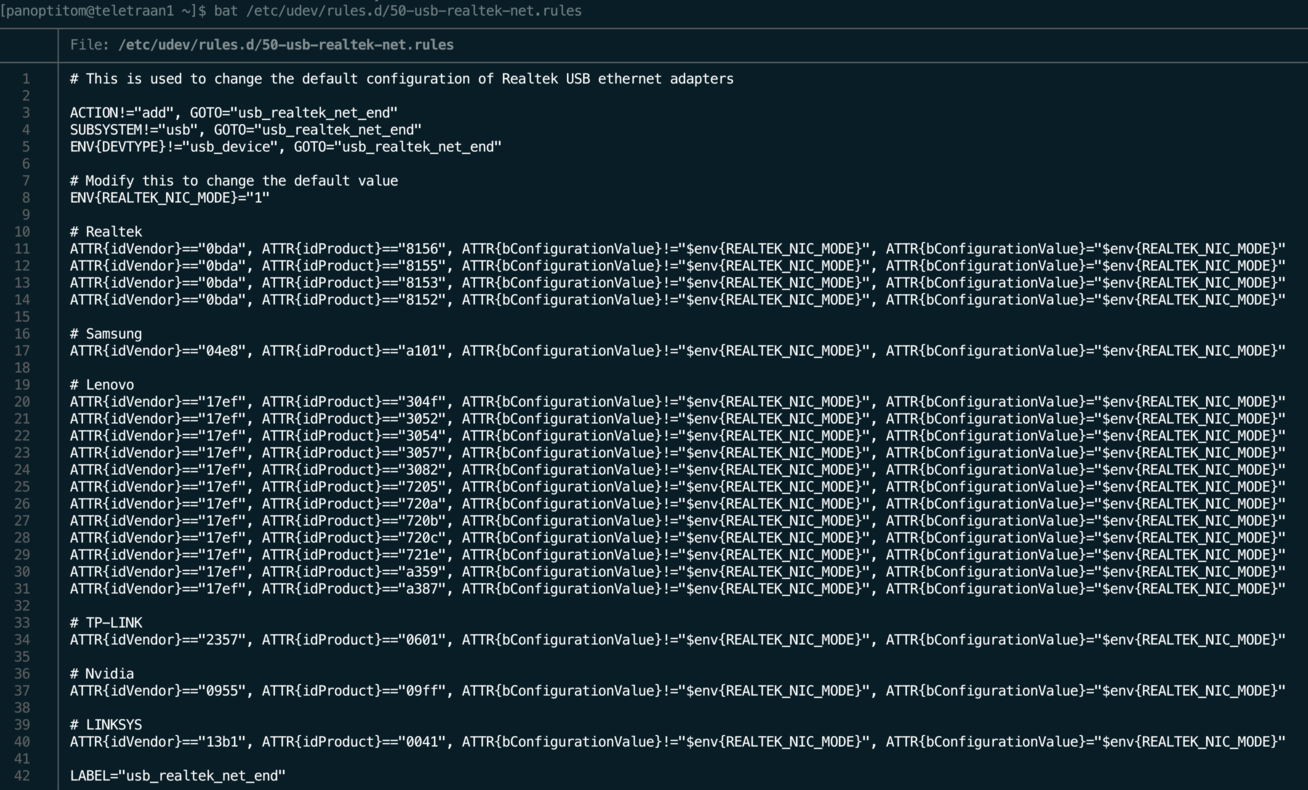Hello!
I just got home and am getting ready to try this.
I noticed you’re using the 5.10.17-2 kernel. I’m currently running 5.11.0-3. Should I update the version number?
I see the 5.10 headers and the 5.10 (UDL) version of the kernel, but I don’t see the 5.10.x version of the kernel for download…
EDIT: Also, did you use these Udev rules provided by Realtek with the 2.14 version of their linux driver?
The NIC mode appears to relate to the fact that this thing has multiple operation modes. I’m not sure what they each do, yet. Regarding modes, here’s what usbview has to say:
USB 10/100/1G/2.5G LAN Manufacturer: Realtek Serial Number: 000000001 Speed: unknown USB Version: 3.20 Device Class: 00(>ifc ) Device Subclass: 00 Device Protocol: 00 Maximum Default Endpoint Size: 9 Number of Configurations: 3 Vendor Id: 0bda Product Id: 8156 Revision Number: 30.00 Config Number: 1 Number of Interfaces: 1 Attributes: a0 MaxPower Needed: 512mA Interface Number: 0 Name: (none) Alternate Number: 0 Class: ff(vend.) Sub Class: ff Protocol: 00 Number of Endpoints: 3 Endpoint Address: 81 Direction: in Attribute: 2 Type: Bulk Max Packet Size: 1024 Interval: 0ms Endpoint Address: 02 Direction: out Attribute: 2 Type: Bulk Max Packet Size: 1024 Interval: 0ms Endpoint Address: 83 Direction: in Attribute: 3 Type: Int. Max Packet Size: 2 Interval: 128ms Config Number: 2 Number of Interfaces: 2 Attributes: a0 MaxPower Needed: 512mA Interface Number: 0 Name: Alternate Number: 0 Class: 02(comm.) Sub Class: 0d Protocol: 00 Number of Endpoints: 1 Endpoint Address: 83 Direction: in Attribute: 3 Type: Int. Max Packet Size: 16 Interval: 16ms Interface Number: 1 Name: Alternate Number: 0 Class: 0a(data ) Sub Class: 00 Protocol: 01 Number of Endpoints: 0 Interface Number: 1 Name: Alternate Number: 1 Class: 0a(data ) Sub Class: 00 Protocol: 01 Number of Endpoints: 2 Endpoint Address: 81 Direction: in Attribute: 2 Type: Bulk Max Packet Size: 1024 Interval: 0ms Endpoint Address: 02 Direction: out Attribute: 2 Type: Bulk Max Packet Size: 1024 Interval: 0ms Config Number: 3 Number of Interfaces: 2 Attributes: a0 MaxPower Needed: 512mA Interface Number: 0 Name: Alternate Number: 0 Class: 02(comm.) Sub Class: 06 Protocol: 00 Number of Endpoints: 1 Endpoint Address: 83 Direction: in Attribute: 3 Type: Int. Max Packet Size: 16 Interval: 16ms Interface Number: 1 Name: Alternate Number: 0 Class: 0a(data ) Sub Class: 00 Protocol: 00 Number of Endpoints: 0 Interface Number: 1 Name: Alternate Number: 1 Class: 0a(data ) Sub Class: 00 Protocol: 00 Number of Endpoints: 2 Endpoint Address: 81 Direction: in Attribute: 2 Type: Bulk Max Packet Size: 1024 Interval: 0ms Endpoint Address: 02 Direction: out Attribute: 2 Type: Bulk Max Packet Size: 1024 Interval: 0ms


